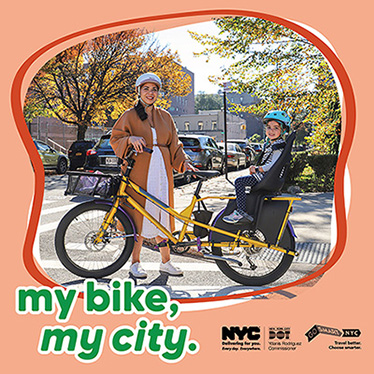Bike Safety
Cycling is one of the truly great ways to travel around New York City—biking is efficient, affordable, equitable, healthy, and environmentally friendly.
On This Page
-
my bike, my city.
Bike Smart: The Official Guide to Cycling in NYC
Bike Events
Helmet Fitting Tips
Biking Myths vs Facts
NYC Biking Laws
Safety Tips
Children on Bicycles
NYCycles Newsletter
my bike, my city.

NYC DOT's My Bike, My City. campaign promotes cycling for all—particularly women, girls, transgender, gender nonconforming, and families—to embrace the mode as a fun, healthy way to get around. The campaign offers New Yorkers resources such as cycling tips, informative events, and safe biking routes.
View family-friendly guided ride details in the NYC Family Bike Tours (1 to 2 miles)
Bike Smart: The Official Guide to Cycling in NYC
Bike Smart: The Official Guide to Cycling in New York City is a helpful handbook with information on making your cycling trip safer and easier, including tips on using newer bike facilities such as protected lanes and bike boxes, and basic tips for locking your bicycle. NYC DOT distributes up to 135,000 copies per year of the New York City Bike Map, which contains the most important rules of the road highlighted in the Bike Smart Guide.
Download Bike Smart in English, Arabic, Bengali, Chinese, Haitian Creole, Italian, Korean , Polish, Russian or Spanish
Bike Events
Each spring and fall, NYC DOT celebrates cycling by hosting events for Bike Month (May) and Biketober (October).
Visit the Bike Events calendar for bike-friendly events hosted throughout the year.
Bike Helmet Fitting Tips
Looking for a new bike helmet? Here are six steps to find the right bike helmet and wear it safely.
Six Steps to Properly Fit a Bike Helmet Watch our video for tips to safely fit your bike helmet (YouTube)
Biking Myths vs Facts
Challenge your NYC biking knowledge by reviewing these biking myths and facts.
- Biking takes too long. FACT: More than half of peak hour taxi trips would be faster if taken on a bike.
- Riding a bike in NYC is too dangerous. FACT: Cycling risk is very low and can prolong your life. Cycling commuters have roughly half the risk of developing heart disease.
- My bike will get stolen. FACT: While an unlocked wheel can be a target, a bike lock can prevent theft. Stolen bikes can be covered by renters’ insurance.
- I’ll get too sweaty. FACT: Biking takes half the energy of walking and you can bike in regular clothes.

NYC Biking Laws
Cyclists have all the rights and are subject to all of the duties and regulations applicable to drivers of motor vehicles.
- Stop at red lights and stop signs. Most serious cycling injuries (89%) occur at intersections.
- Go with the walk, unless there is a bike signal or sign, cross the intersection when the pedestrian signal shows “the walk".
- Yield to pedestrians. People walking may not see or hear you coming. Nobody likes to be startled!
- Ride in the direction of traffic. That’s where people expect to see you.

Safety Tips for a Safer Ride
- If you can’t see the driver they can’t see you. Use extra caution when passing trucks, buses, or approaching an intersection alongside a larger vehicle.
- Be sure to be seen when stopped. At red lights, stop to avoid the driver’s blind spot – slighting ahead of a waiting vehicle.
- Be seen to avoid collision. Use a white headlight and red taillight at night.
- Be aware of your surroundings. Do not wear more than one earphone while riding. Check behind you, especially changing lanes.

Look Out for Others
- Watch: Look out for people with long white and red canes or traveling with guide dogs.
- Wait: Always let people walking go first and keep the crosswalk clear. Remember, pedestrians have the right of way on shared paths and Greenways. Do not ride up behind or around a guide dog and owners.
- Warn: Slow down near people walking, and ring your bell or call to let them know you’re coming close.

Cycle Eyes Video
While we continue to promote cycling as a means of transportation, we also want to help you identify our 175,000+ low vision or blind pedestrians.
Watch an audio described version of the Cycle Eyes video
For Children on Bicycles
- Children under age one cannot be carried on a bicycle.
- Children must be carried in a properly affixed child carrier.
- Cyclists 13 or younger must wear an approved helmet.
- Children 12 or younger should ride on the sidewalk, while adults must ride on the street.
NYCycles Newsletter
The official newsletter of NYC DOT's Bicycle Program is NYCycles, an email newsletter providing updates on new bike lanes, bike-friendly events, and tips for new and experienced riders.
